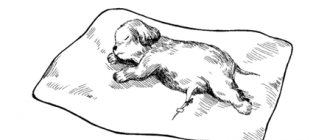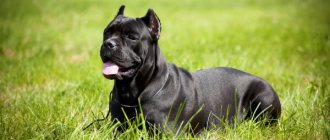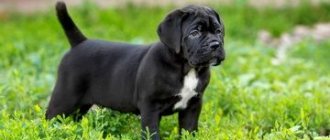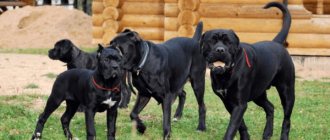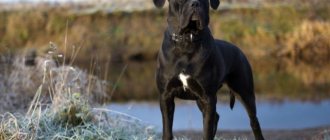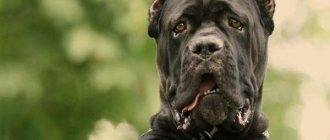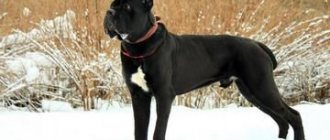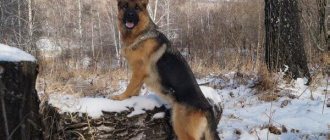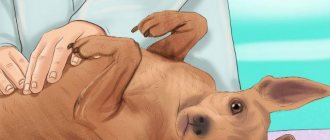A breeding female of the Cane Corso breed is purchased for subsequent breeding and production of high-quality offspring.
When selling a puppy, experienced breeders must indicate whether it has the makings of a real breeding breeder or whether it will become a star in the ring , or perhaps become a pet.
This clarification is important, since the owner, immediately after the first heat, begins to look for a suitable male, negotiate with his owners, plan the time and calculate the amount he is willing to pay for mating.
How long does a Cane Corso girl's first heat last?
Cane Corsos mature and mature late, like most large dog breeds. A six-month-old female Cane Corso is still considered a puppy, and only at eight months does the girl begin puberty, the main sign of which is the first heat .
Pustovka is also called the first heat, during which ovulation may not occur, since the teenager’s body is still forming, the reproductive system, subject to hormonal changes, becomes perfect.
The time of the onset of the first heat is always individual; emptying can begin at eight months or after a year. Beginning breeders are always interested in how long the Cane Corso's first heat lasts. On average, the process lasts three or even four weeks, but for each dog it proceeds differently.
Most often, during emptying, spotting is scanty, almost invisible . Occasionally, owners notice a few drops of blood on the floor, but it also happens that after a three-week sluggish process, the discharge from the bitch’s loop intensifies, becomes dark and profuse. This is also a variant of the norm, since the hormonal background has not yet been established.
Near Voronezh, a Cane Corso dog gave birth to a record number of puppies
If there was a dog kindergarten, it would look about the same as the house of Albert and Natalya Mukhomedeev’s family in Ramon now. Their Cane Corso dog Kira gave birth to 19 puppies (unfortunately, one baby did not survive). Now there are 18 of them, the babies are just over a month old. They are incredibly cute, especially when they play with each other or drink milk in a whole crowd, and their mother is trying to somehow control such a large offspring.
The birth of almost 20 puppies at once is very rare. For example, in 2011 in China, a female Tibetan mastiff gave birth to 19 puppies; in the USA, in 2015, a Great Dane named Velma also gave birth to 19 puppies. The birth of 19 Cane Corso puppies has not yet been recorded. So maybe Kira has a world record.
Kira could not feed all the puppies on her own
Photo: Igor FILONOV
The dog's owners say that nothing predicted that Kira would become a heroine mother. The dog is two years old, and this is her first offspring.
“As the dog handler told us, a Cane Corso usually gives birth to 2-3 puppies for the first time,” says Albert.
Kira appeared in the Mukhomedeev family two years ago. Albert went to Oryol to get the puppy; he says there were no suitable offers in Voronezh. We settled on the Canne Corso breed because these dogs are friendly and good with children. The owners took Kira to classes with a dog handler, the dog repeatedly participated in all-Russian exhibitions and always received an “excellent” rating.
Her owners approached the birth of Kira's first offspring responsibly. They spent a long time choosing a “groom”, and eventually settled on a dog named Pharaoh, who also became a dad for the first time.
“Kira and Pharaoh had love at first sight, they immediately became friends,” says Pharaoh’s owner Andrei Rezov. — Farik also has a kind character. He is a well-mannered dog, he passed the exam on the general training course. And also, which is quite rare for the Cane Corso breed, it turned out to be very jumping and takes a barrier of 1.7 meters.
Kira's owners say that some magic of numbers happened with the birth of the puppies. 19 babies were born in 2021 on the night of January 19, and Pharaoh was also born on the 19th.
“Kira’s first puppy appeared late in the evening, and then they started to fall asleep all night until five in the morning,” says Natalya. “We thought, well, there will be three puppies, well, six at the most.” It was a crazy night for us. Kira managed it herself, she didn’t need help. The first two days we controlled the feeding process - we fed Kira the puppies in batches of six.
From the third day of the puppies' life, the dog's owners began to feed them with a special mixture, because Kira did not have enough milk. Natalya says that she even had to take time off to care for the babies - she had to feed them every two hours.
Now the puppies have grown up and become stronger. At first glance, it seems that they are all the same, but the owners can already distinguish them and all 18 of them have come up with nicknames starting with the letter “M” - Marquise, Mavrik, Max and others. Each puppy will have their own passport after they have received the necessary vaccinations.
The Mukhomedeevs claim that they distinguish between puppies and gave each one a name starting with the letter M
Photo: Igor FILONOV
Veterinarian Vera Shchetinina comments that the case of a dog giving birth to 19 puppies at once is unique.
“In my 36 years of work, there has never been such a case,” says the veterinary specialist. – As a rule, the maximum number of puppies that can be born to dogs, even large breeds, is 9 - 10.
Read a report about how the Mukhomedeev family copes with 18 puppies, how many liters of milk a day the cubs drink, and how the cat Buska reacted to such an addition in the issue of the newspaper “MY!” from February 26 and in the digital version “MY! Plus".
Reference:
The Cane Corso breed was bred in Italy during the Roman Empire, the breed is focused on protection and security, and previously these dogs were used for hunting and for driving livestock. Dogs are strong, resilient, smart and loyal. Without a serious reason or without a command, the Cane Corso does not show aggression. From an early age, the Cane Corso must undergo a course of general training in order to become a socialized dog.
How to choose the right male
After the bitch has finished her first heat, the owner thinks about selecting a pair for his pet. In the RKF system, to which most Russian clubs belong, there is a rule: before eighteen months, mating of Cane Corso (females) and other large breeds is prohibited .
That is, even if the dog starts her next heat before this age, she will have to miss it. The ban is due to the late physical development of the Cane Corso , as well as the need to obtain permission for breeding. To do this, the bitch must receive a show grade and pass obedience tests.
A stud dog is selected based on the following criteria:
- The male must be better than the female in appearance. A stud dog must have titles no lower than “Junior Champion” for young dogs and “Champion” for dogs over two years of age. A male dog that has one or more “excellent” ratings, but does not have titles, has exterior defects. Of course, even titled males have shortcomings, but they are insignificant, and the advantages of the exterior clearly prevail.
- The male must be prepotent. Prepotency is a concept that means that a male dog necessarily passes on his best qualities to his offspring. Simpler - most puppies from such a male will look like him. This quality can be easily verified by asking the descendants of the manufacturer how many of them have awards and titles.
- The male must be of the same type as the female. There are several types of the Cane Corso breed that differ in general build. For example, there are massive, heavy dogs, and there are drier, more elegant ones.
After a verbal agreement with the owner of the dog, the owner of the bitch must take a referral for mating at the nearest club and fill it out. Mating is carried out on the tenth or twelfth day of estrus, repeating it every other day. The completed mating certificate, along with copies of the pedigrees of both dogs, original diplomas with an assessment and copies of all title diplomas, is taken to the club, where after the birth of the puppies they receive birth certificates for the babies .
Puberty of dogs, estrus, mating.
The ability to reproduce in dogs appears early - at 8-12 months. But a young, not yet strong animal’s body is not able to withstand the colossal load caused by mating, pregnancy, childbirth and feeding puppies. Early matings also have an adverse effect on male dogs that have not yet completed their formation. In addition to undesirable physiological changes, early matings cause many diseases, the treatment of which in the future is problematic. Dog breeding practice determines the most favorable timing for the start of breeding for males at the age of 24 months, for females at the age of 20 months. But when planning the first mating of a dog, you should take into account its individual characteristics. Some dogs complete their physiological development relatively early, while others take much longer to develop. An objective indicator of the physiological maturity of a bitch is the onset of her third heat, for which mating should be planned. Preparing the dog for mating. Mating should be planned in advance, focusing on the timing and course of the previous estrus. An experienced breeder must keep a diary in which he regularly records observations of the health, condition, physical fitness and physiological characteristics of each of his dogs. In females, it is recommended to describe in detail the course of each heat, from the first to the last day, even if mating during this heat is not planned. Everything is important - the timing of the start and end of estrus, the intensity and nature of the discharge, the state of the “loop” and the behavior of the bitch on each of the following days, her reaction to the male. Data on various preventive measures is also entered here. Having such records, in the future you will accurately determine the timing of the next heat and, most importantly, the moment the bitch is ready for mating. The breeder must begin taking mandatory preventive measures in advance. 1.5 months before the expected estrus, it is recommended to conduct a bacteriological analysis to identify hidden anaerobic infections in the bitch (staphylococcal, streptococcal, herpesvirus, etc.). These infections are currently quite widespread in the dog population, but without appearing externally, they often cause the death of puppies at various stages of development. This simple preventive procedure (tests are done in any veterinary laboratory by taking blood from a vein and swabs from the bitch’s vagina) will save you from possible problems in the future. The cost of tests, and even, if any infection is detected, a full course of treatment for the dog will be much cheaper than the loss of the entire litter. By the way, stud dogs must also regularly undergo this preventive measure, and their owners are required to provide a certificate of absence of anaerobic infections upon the first request of the owners of bitches. About a month before estrus, mandatory preventive treatment of the bitch against skin parasites (fleas, lice, subcutaneous mites, etc.) is carried out. In this case, the most effective is the use of special, non-toxic sprays and shampoos. Long-acting products are not suitable - in particular, anti-parasitic collars. A few days after this, it is necessary to deworm the bitch with one of the broad-spectrum drugs (for different types of parasites), the dosage of which is calculated strictly in accordance with the instructions. A week after deworming, the dog should be vaccinated against the most common and dangerous infectious diseases. Before mating, bitches are vaccinated only with imported polyvalent vaccines, which will significantly increase the immunity of puppies at an early age. All these activities are mandatory when preparing a dog for mating and are carried out before the onset of estrus. At the time of mating, the bitch must be absolutely healthy. She should not be thin, weakened, or, conversely, overfed, with flabby muscles. This will inevitably have a negative impact on the course of pregnancy and childbirth. Estrus (estrus) The first heat in bitches usually occurs at the age of 8-12 months, and then repeats at approximately the same interval after 6 months, that is, approximately twice a year. Its duration is on average 18-20 days. But some deviations from these norms are possible, which is an individual feature of each individual. Physiological disorders should be considered the onset of the first estrus earlier than 7 and later than 15 months, the interval between estrus is less than 4 and more than 9 months, the duration of estrus is less than 12 and more than 30 days. About a week before the onset of heat, the dog's behavior may change - it becomes disobedient, excitable, and sometimes loses its appetite. The onset of estrus is characterized by some swelling of the vulva (“loop”), and after some time the appearance of bloody discharge from it. At the beginning of estrus, the “loop” is usually enlarged, but hard, and the discharge is bloody and scanty. After two or three days they become more abundant. Approximately seven to ten days after the start of estrus, the “loop” begins to increase in volume, and the discharge gradually becomes lighter. By the time of ovulation (the release of mature eggs ready for fertilization from the ovaries), the “loop” increases to its maximum size and becomes soft, and the discharge becomes yellowish-pink in color. The behavior of the bitch changes accordingly - she flirts with the males, and when they “court”, she takes the appropriate position, moving her tail to the side. The bitch often takes the same pose if you stroke her in the croup area or touch the “loop”. This is the most favorable period for breeding a bitch. Most often it occurs 12-15 days after the start of estrus, but some deviations from this period in one direction or another are possible. The duration of ovulation (the number of days during which a female dog can be fertilized) also varies, but on average it is 3-5 days. It is recommended to breed a bitch in the middle of its readiness. The most common mistake breeders make is mating on the first day of the appearance of the above signs, that is, at the very beginning of ovulation. This usually results in an empty female dog or a small number of puppies in the litter. It happens that not all signs are equally expressed when the bitch is ready for mating. Sometimes the discharge only slightly brightens at the time of ovulation, or, conversely, throughout the entire estrus it is not abundant and bright enough. It is extremely rare, but there are females with so-called “bloodless” estrus, when the discharge is so scarce that it is simply impossible to see it. There are females whose “loop” remains rigid throughout the entire estrus and practically does not increase in size. Some bitches even during the period of ovulation show aggression towards the male. All these deviations can have a wide variety of reasons, but often this does not prevent such bitches from giving birth to normal, healthy puppies. To ensure that your mating plans are not disrupted and your efforts are not in vain, you need to know the individual characteristics of your dog and be able to determine in advance the days that are optimal for mating. If this is the first mating, this is where the observations and notes you made during the previous heat will help. Based on them, you can easily determine the days that are most favorable for a trip to the dog. Knitting. It is the bitch that is taken to the dog for mating, and not vice versa. There are several reasons for this, but the main one is that male dogs tend to be more active at home. It is best to breed in the morning, before feeding the dogs. Before mating, even before the dogs see or feel each other, each one needs to be given a good walk. Often this is not given much importance, and at the same time, a full intestine in a bitch is the most common reason for mating without a “lock”. A male with a full intestine or bladder is unlikely to recover in the presence of a bitch, and this will turn out to be a serious reason for unsuccessful mountings. Dogs are knitted in a secluded place, in the absence of extraneous irritants nearby and with as few people present as possible. The dogs are given the opportunity to get acquainted, sniff, and play a little. But, it is important that the game does not drag on, as the male may “burn out” and the mating will not work. Immediately before mating, the bitch’s “loop” should be lubricated with Vaseline or baby cream. The owner of the bitch stands in front of her and holds her by the collar. The owner of the dog sits down on the side of the bitch, supporting her under the belly with one hand, and with the other, directing the “loop” to the male’s genitals during mounting. Such assistance is necessary to save the dog’s strength and prevent possible injuries during mating. An active and healthy male usually mates a bitch without difficulty after several matings. But there are cases when, due to a mismatch in the size of the dogs or the structure of their genitals, mating does not occur for a long time. In this case, the help of an experienced instructor is necessary (sometimes these functions are successfully performed by the owner of the dog), who, depending on the situation, resorts to additional help: using a special stand for the dog, lifting the bitch, pressing the dog closer to the bitch during mounting, etc. In any case, it is strictly contraindicated to touch a male dog’s genitals during mating, as this can cause irreparable harm to his health and psyche. Usually, after several cages, a specific coupling of the genital organs of the male and female occurs, the so-called “lock”, during which the dogs, as it were, remain coupled with each other for some time. This happens because the male penis enlarges after entering the vagina, especially at the base, where the “bulbs” are located, and the circular muscles of the female vaginal opening contract, keeping it inside. The “castle” can last from a few minutes to an hour, or even more. The presence and duration of the “lock” depends on both partners, on their physiological compatibility, but it has virtually no effect on the result of the mating. The entry of sperm into the bitch’s vagina occurs at the beginning of mating. Therefore, even if during mating the male “entered” the bitch, ejaculation occurred, but the “lock” did not work out, there is still a possibility that the bitch will be impregnated. During mounting, the male produces characteristic forward frictions, which do not always reach the goal and end in ejaculation. He can repeat mountings at different intervals, jumping off and climbing back onto the bitch, but if this lasts more than 10 minutes, the dog should be taken away from the bitch for a while and given a short rest. During the cage, it is not recommended to press on the male’s croup and press him closer to the bitch. Experienced instructors sometimes resort to this method, but, firstly, they, as a rule, can accurately determine the moment the clutch begins, and secondly, they know which dog this can be applied to and which it cannot. In some cases, this may cause a reverse reaction in a male dog, and he will refuse to breed a female dog. The beginning of ejaculation is easy to notice by the change in the nature of the frictions, when the male, in one of the cages, presses closer to the bitch and, rising on his hind legs, lifts them one by one, as if trying to climb onto the bitch. After a few seconds, he stops friction, remaining on the bitch. At this point, you need to make sure whether a “lock” has occurred. This is easy to do by carefully palpating the “bulbs”, which at this moment should be inside the bitch’s vagina. If one or both bulbs are located outward, there is no “lock”, and the next moment the male will probably “come out” of the bitch and for some time, until the outflow of blood from the enlarged “bulbs” occurs, he will not be in a very comfortable position. pose, with a “naked” penis. This is not harmless to his health. Therefore, if this happens, you should periodically moisten the male penis with boiled water at room temperature using a syringe. If after the next mounting there is a “lock” and the male is on the bitch, you can carefully move one of his front and then the hind legs over the back of the bitch, placing them with their tails facing each other. This is convenient and harmless for both dogs. But this should be done carefully, holding the bitch well. Under no circumstances should you try to separate dogs that are in a “lock” - this will result in very serious damage to the genitals. After mating, the dogs should be immediately separated from each other. The male dog should rinse the preputial sac with chlorhexidine solution. The widespread belief that repeated (control) mating is necessary to guarantee fertilization is groundless. It is more necessary for the owner's complacency than for the bitch herself. If the bitch is healthy and mated during the period of ovulation, fertilization is guaranteed. Owners simply should not allow unprepared bitches to breed, so as not to waste the dog’s strength in vain.Source of information https://best-toy.narod.ru/index/0-18
News archive
| 14.02 Breeding show results On February 14, 2021, a breeding review was held in Elektrogosk Mo under the examination of Yana Adolfovna Gavrilova. Our results: |

